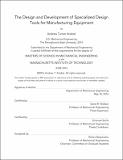| dc.contributor.advisor | David R. Wallace. | en_US |
| dc.contributor.author | Kriebel, Andrew Turner | en_US |
| dc.contributor.other | Massachusetts Institute of Technology. Department of Mechanical Engineering. | en_US |
| dc.date.accessioned | 2016-09-13T18:10:13Z | |
| dc.date.available | 2016-09-13T18:10:13Z | |
| dc.date.copyright | 2016 | en_US |
| dc.date.issued | 2016 | en_US |
| dc.identifier.uri | http://hdl.handle.net/1721.1/104149 | |
| dc.description | Thesis: S.M., Massachusetts Institute of Technology, Department of Mechanical Engineering, 2016. | en_US |
| dc.description | This electronic version was submitted by the student author. The certified thesis is available in the Institute Archives and Special Collections. | en_US |
| dc.description | Cataloged from student-submitted PDF version of thesis. | en_US |
| dc.description | Includes bibliographical references (pages 243-245). | en_US |
| dc.description.abstract | Product development cycles have consistently become shorter, but the timeline for designing and developing manufacturing equipment has changed little. In some cases the time do design manufacturing equipment can be several times longer than the development cycle for the product it will produce. Consequently, manufacturing equipment development is under growing pressure to efficiently produce equipment solutions in reduced time. Building upon lessons from microelectronics design tools and trends in specialized digital design tools, this thesis examines the potential for a platform of modular design tools targeted at the design, analysis, and fabrication of process and manufacturing equipment through the development of the platform's first design tool: a web-based tool for the design and analysis of Cartesian positioning systems. This thesis documents the codification of positioning system design into physical and functional representative models that enable a systematic, yet flexible workflow focused on decreasing development cycle time, reducing error and oversight, and diminishing barriers in the product selection process. In the positioning system design tool, the user first configures a system architecture using rules based on common architectures and defines inputs for work envelope and payloads. The user is then able to search for, compare, and select products from a vendor-submitted part library based upon performance measures and target specifications. The product selections and resulting design are then validated using force and moment analysis, motion path time analysis, and precision analysis. The development effort associated with the tool emphasized the importance of appropriate levels of representation for different tool functions and resulted in a guiding methodology for the development of future design tool modules. | en_US |
| dc.description.statementofresponsibility | by Andrew Turner Kriebel. | en_US |
| dc.format.extent | 255 pages | en_US |
| dc.language.iso | eng | en_US |
| dc.publisher | Massachusetts Institute of Technology | en_US |
| dc.rights | M.I.T. theses are protected by copyright. They may be viewed from this source for any purpose, but reproduction or distribution in any format is prohibited without written permission. See provided URL for inquiries about permission. | en_US |
| dc.rights.uri | http://dspace.mit.edu/handle/1721.1/7582 | en_US |
| dc.subject | Mechanical Engineering. | en_US |
| dc.title | The design and development of specialized design tools for manufacturing equipment | en_US |
| dc.type | Thesis | en_US |
| dc.description.degree | S.M. | en_US |
| dc.contributor.department | Massachusetts Institute of Technology. Department of Mechanical Engineering | |
| dc.identifier.oclc | 958279131 | en_US |
